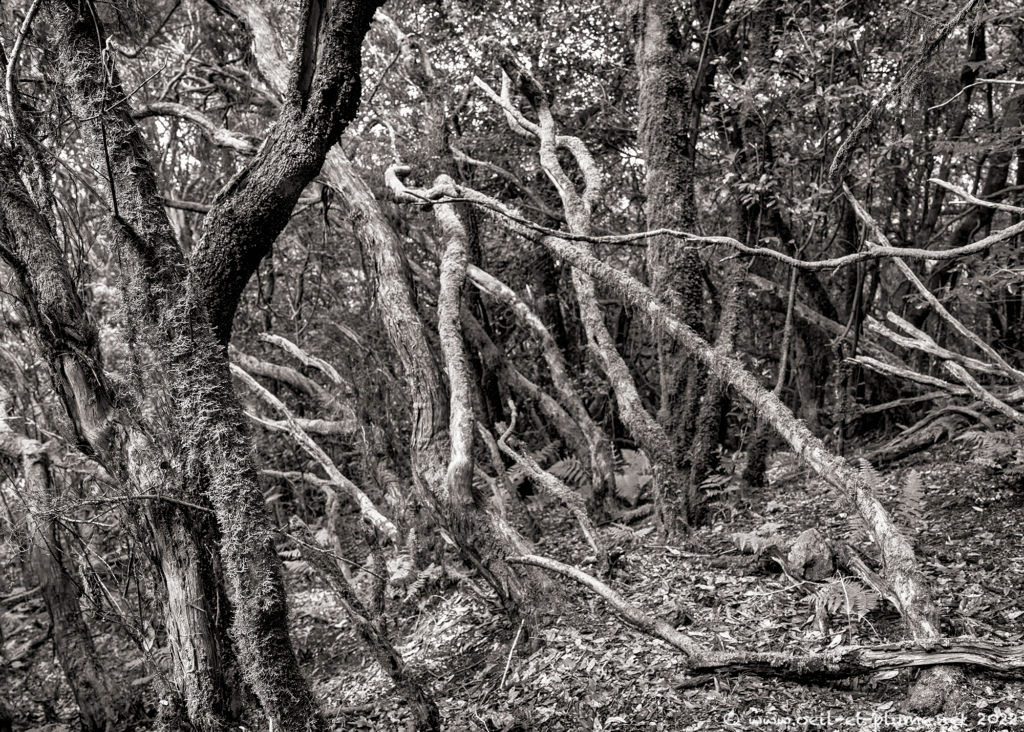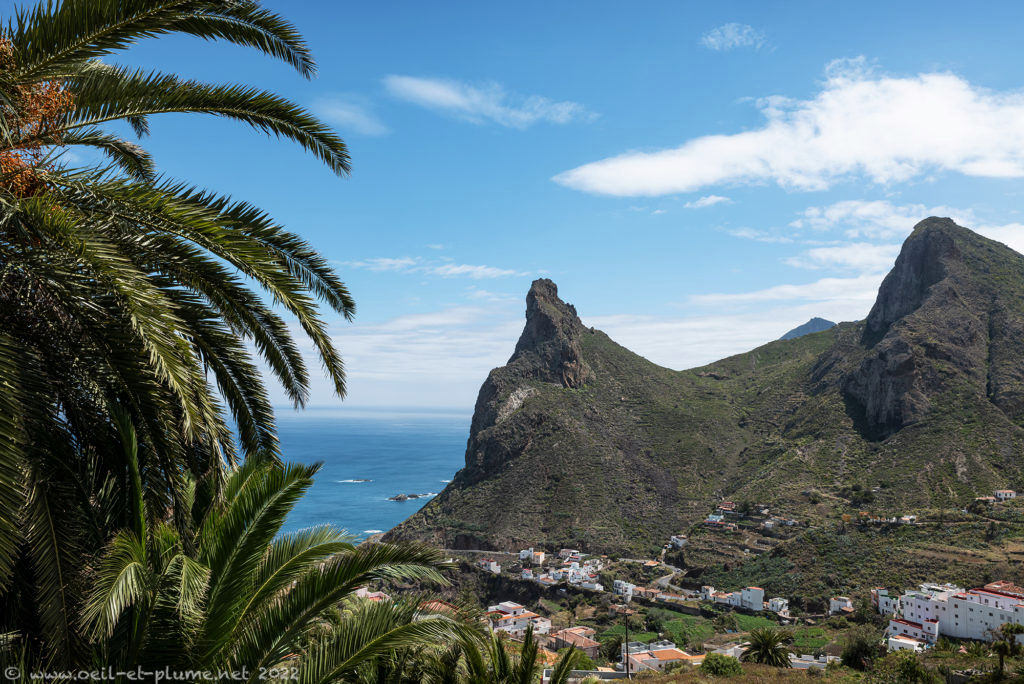All of a sudden, I stop my rented car in the middle of the narrow road lane. Looking at the rugged landscape scenery, I imagine mentally the daunting forging work that created those tormented shapes million years ago, fuelled by a fire from deep inside Mother Earth. I also hear the winds and the feel rain polishing the lava rocks tirelessly since then. The Anaga spirit already inhabits me.
Anaga mountains
We are in the Anaga massive located in the northeastern corner of Tenerife island. Tenerife is a volcanic island that has built up from the ocean floor over time. This is the oldest part of the island, as it was formed by a volcanic eruption from 7 to 9 million years ago. So is the vegetation growing there. Over there, the Mount Teide oversees the body of natural work, apparently in a deep state of somnolence.

Legend in Tenerife has it that once upon a time, the devil Guayota kidnapped Magec, the god of light and sun. The devil held his prisoner inside of the fiery depths of the Mount Teide, throwing the outside wold into darkness. Native people prayed to their supreme god Achaman, begging him to save Magec, and to bring back light to their world. In the ensuing battle, Achaman defeated Guayota. Achaman then freed Magec and so restored light in Tenerife. As punishment, Guayota was trapped inside the volcano where the devil remains to this day.
As I am brave but not foolish enough to defy the fearsome Guayota, I kept the Mount Teide at bay during my stay in Tenerife. Luckily, the Macizo de Anaga (Anaga massive) is a fascinating and far less visited area within the otherwise crowded and touristy Tenerife.
Despite its modest size, the island of Tenerife displays a remarkable ecological diversity which draws upon many specific environmental conditions, producing a variety of microclimates. In more simple terms, you can enjoy sunny and warm days on the coast, and expect fog and rain and even snow when heading to the Anaga mountains. The volcanic massive is worth of interest, as it host very old forests and many endemic species.
Anaga forests
The Anaga massive is often depicted as a hiking and cycling paradise. I spent quite some time hiking there, not enough to my taste but certainly long enough to enjoy its atmospheric landscape blurred with mist banks and rain drops. I often laid down often in the beautiful vegetal compositions found here and there on my way. My hands followed the twisted shapes of trees beautifully draped in their moss dress. My ears listened carefully about their tormented life stories and their resilience. My fingers skimmed at length the delicate fern leaves. I still smell the perfume of laurel trees and other odourant bushes and plants.
The experience proved to be enchanting, bewitching even. In a place called El Bailadero, witchcraft and dancing around a bonfire used to be common practice, according to local hearsay. I manage nonetheless to reset my journey into the Macira Anaga.
On my way, steep-walled gorges penetrate far into the mountain range in successive waves from the Anagan coast. Spectacular pieces of volcanic rock emerge from the Atlantic Ocean, like periscopes of a submarine underworld. In the 16th and 17th centuries, some scientists strongly contended that the ruined and lost Atlantis would lay underneath the Canaries archipelago. The latter would thus corresponds to the higher elevations of the mythical continent.
Anaga people
There is a much stronger scientific evidence of the early presence in the Anaga massive of the Guanches. The only indigenous people, the Guanches arrived on the Canaries archipelago in the first millennium BC. They hailed most probably from Northern Africa as their genetic identity resemble to the one of the Berbers.
Many villages in the Macizo de Anaga display legacies of Spanish colonial times. Spain conquered the Canaries archipelago in the second half of the 15th century. During the Spanish colonial period, Tenerife was closely connected with Latin America. Spanish ships used to stop at the island to resupply on their way to and from the New World.
Taganana
My favourite Anaga village, Taganana is located at the very end of a long, narrow, winding and treacherous road. Before getting there, I already fell in love with its exotic name. The charming settlement spreads from the ocean shore over very steep slopes until arge and rugged rocks surrounded by thick forests.
I loved Taganana so much that my blurred mind possessed by the Anaga spirit borrowed a few elements gathered in other locations in Tenerife. Never mind, what follows is the Taganana of my feelings, dreams and thoughts since I visited the place.
Interesting enough, the settlement was founded by Portuguese colons and their slaves in the 17th century. The new settlers hailed from Madeira island further north in the Atlantic Ocean, looking for new pieces of land to cultivate sugar can and corn. Later on, they added wine yards and other farming products.
The colons’ first concerns upon arrival in Taganana were security and export routes. The early settlers elected the heights of the small valley in a concern for safety. Over time, the village expanded and reflected the social stratification of its population, with the richest families living in the higher parts of the settlement.
The early settlers also looked for a safe way to ship the sugar produced in Taganana to Santa Cruz de Tenerife, the main maritime port of the island. Shipping the goods by sea was not a good option. To do so, their African slaves built a long and pathway across Anaga mountains to the southern shore to reach Santa Cruz. Nowadays, the pathway leaving Taganana south across the Maciro de Anaga is a beautiful but physically demanding hiking trail for aficionados.
Out of lack of time, I trekked on that historical path only for a short while. While walking, I thought much about those unfortunate people having built and used the rocky and steep pathway for years under scorching heat or cold rain, carrying heavy loads of goods. Their physical achievements far exceeded our contemporary sport performances. To do so, they must have been invigorated by the Anaga spirit indeed.
To continue here.


































